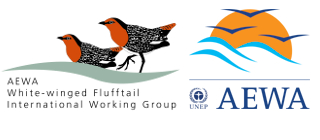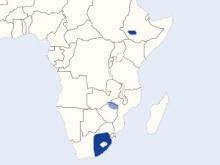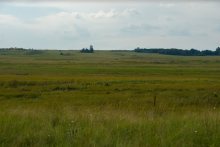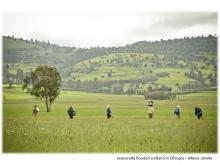Current Size: 76%
An elusive species facing numerous challenges
BIOLOGY
It is one of nine flufftail species, a family related to crakes and rails, that are small, secretive, ground-living birds which typically reveal their presence only by their ghostly hooting calls.
White-winged Flufftails are small, almost mouse-like birds weighing a mere 30-35 grams according to published literature. Birds recently weighed in Berga wetland, Ethiopia, weighed between 25 and 35g, averaging a mere 30g. They are streaked, with brownish plumage, a rusty head, chest and tail, a wingspan of about 16 cm, and broad characteristic white secondary wing feathers that briefly render them conspicuous in flight.
Whereas the calls of the other species are well-known, there is much confusion about the calls of the White-winged Flufftail, and this compounds the inherent problem of finding and learning more about the species.
HABITAT
White-winged Flufftails have rather specific habitat needs. In Ethiopia they favour seasonal flooded wetlands, stretches of grass and sedge standing about knee-height in ankle-deep water in summer. In South Africa, by contrast, the wetlands used by these flufftails are permanently or semi-permanently wet, and they are typically sponges located near the headwaters of rivers in the eastern Highveld, which are wet underfoot, and dominated by the sedge Carex acutiformis, a broad-leafed plant that forms a closed canopy about 1- 15 cm high above the ground layer of damp ground or shallow water.
The presence or absence of the birds here seems linked to water-level - they are absent when it is too deep or too dry. Fire occurrence and grazing pressure might also play a role, but this still needs to be tested by a field experiment. Much remains to be learnt about this bird's habitat requirements and guesswork needs to be replaced by fact.
Until 1996 the White-winged Flufftail had only been found at Middelpunt, Wakkerstroom and Franklin Vlei. The Middelpunt Wetland Trust then funded Dr Barry Taylor, a renowned world Rallidae expert, to travel to Ethiopia to study a site at Weserbi. Here, during an IBA survey in 1995, the bird was miraculously "rediscovered". Dr Taylor found that the bird occurred in a mixed-grass marshland habitat that was in total variance to the Carex sedge of its South African habitat. He also discovered a female with three chicks ó the first recorded breeding site.
On his return to South Africa, this discovery prompted him to investigate wetlands which approximated the Ethiopian habitat. This led to the discovery of two new sites in East Griqualand: Hebron and Penny Park, and four in the highlands of the Eastern Free State: Murphyís Rust, Chatsworth, Vanger and Zeekoeivlei.
STATUS AND DISTRIBUTION
The White-winged Flufftail is an endemic resident to Africa and is only known to occur in the high altitude wetlands of South Africa and Ethiopia. There are isolated records from Zambia and Zimbabwe. It is speculated that the bird migrates between these two countries, arriving at suitable habitat within South Africa in the Austral summer. However, this migration theory has not been conclusively proved.
Ten years ago the South African population, was estimated at 235 non breeding individuals occurring in ten sites ranging from 50ñ1,000 ha in area and at altitudes of 1,300 ñ 1,870 m in the east of the country. The only known breeding population, estimated at 201+ pairs is found at three sites in highland marshes in the central highlands of Ethiopia near Addis Ababa. More recent estimates show that there are a mere 50 birds left in South Africa and less than 250 globally. In January 2018, the first evidence of White-winged Flufftail breeding in South Africa was documented on a camera trap set up by Robin Colyn, one of BirdLife South Africa's lead researchers on the White-winged Flufftail project.
The White-wined Flufftail was ranked as "Critically Endangered" in 2013 on the IUCN based on the C2a(i) criteria. This uplisting was due to its small population size which is believed to be declining with shrinking suitable habitat in both Ethiopia and South Africa.
THREATS AND CHALLENGES
In South Africa it is severely threatened by habitat destruction and degradation, including impacts of mining activities, wetland drainage, various agriculture-related activities including crop farming, afforestation, grazing, water abstraction, horticulture, peat fires, draining, erosion, siltation, fences and developments such as roads, dams and buildings. Its habitat is believed to be undergoing a continuing decline. For example, all potentially suitable White-winged Flufftail wetland habitat around Durban has been destroyed as a result of intensive agriculture (especially sugarcane farming), industrialization and the proliferation of human settlements.
The marshes occupied by the breeding population in Ethiopia are intensively grazed and threats include trampling and grazing by livestock and cutting of marsh vegetation for fodder. Livestock numbers are increasingly growing and the resultant grazing severely reduces the sward length in breeding habitat. Grasses and sedges are also cut for the culturally important Ethiopian coffee ceremony.










